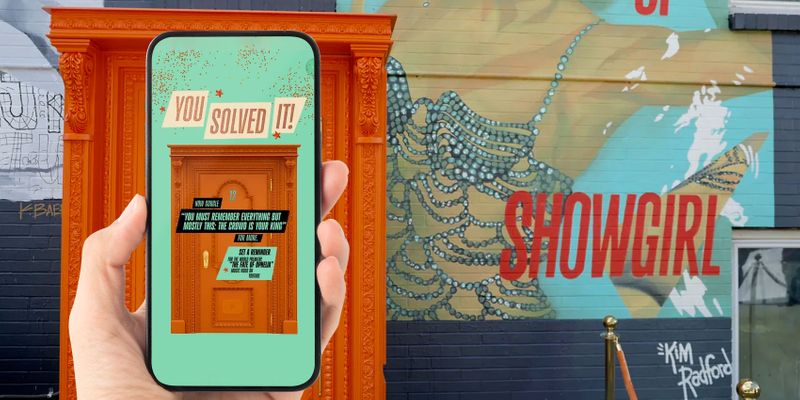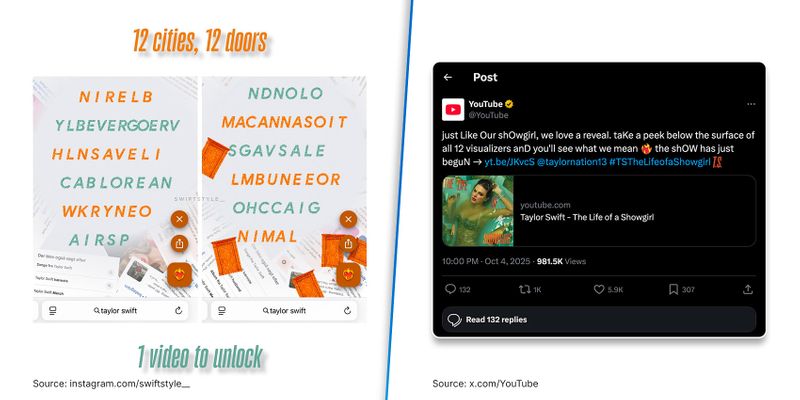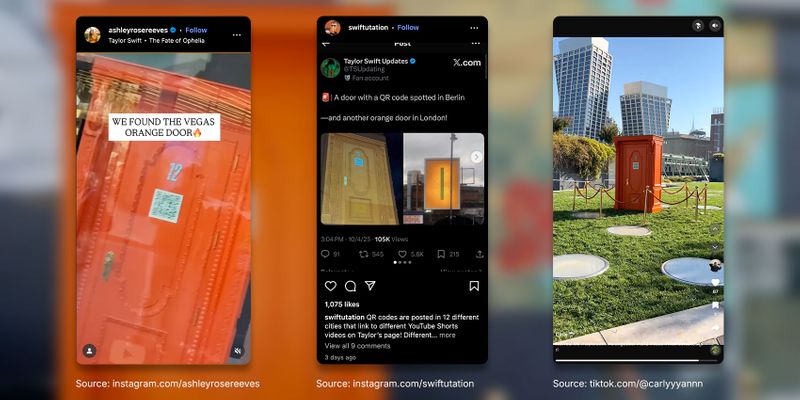Taylor Swift’s “Life of a Showgirl” QR Code Puzzle Becomes a Global Scavenger Hunt

On October 4, 2025, an orange door with a QR code appeared in Berlin. With it, Taylor Swift’s latest album rollout became anything but ordinary.
As part of her 12th studio album marketing, Taylor Swift’s “Life of a Showgirl” QR code puzzle set in motion a global scavenger hunt that has taken fans from screens to city streets and back online.
Across 12 different cities, from Berlin to Beverly Grove, Taylor Swift’s team placed mysterious orange doors, all featuring a QR code that reveals AI-generated YouTube Shorts packed with puzzles, hidden letters, and callbacks to Swift’s past eras.
The mission: collect all of Taylor Swift’s door QR code clues to unlock a secret video. The campaign’s main hint sums it up best: “12 cities, 12 doors, 1 video to unlock.”
Table of Contents
Setting the stage

The digital tie-ins run deep. Searching “Taylor Swift” on Google triggers a burning heart icon that is actually one of Taylor Swift’s cities puzzle.
Each subsequent click on the emoji led for the search page to shatter, creating an illusion of a broken mirror, and then revealed 12 scrambled city names for fans to decipher.
At the same time, cryptic posts on social media added even more layers to the mystery. YouTube’s X (formerly Twitter) account spelled “LOOK DOWN,” prompting fans to follow a trail of digital breadcrumbs.
The central clue, “12 cities, 12 doors, 1 video to unlock,” urged fans to collect words or letters from each video QR code to form a message that ultimately unlocked exclusive content.
The show begins: QR code discoveries and fan participation

The orange doors themselves became the centerpiece of the campaign’s excitement, with each location gathering crowds of fans who were eager to join the QR code scavenger hunt and uncover clues.
Early discoveries included an orange door in Berlin. Scanning Taylor Swift’s Berlin QR code led to a YouTube Short containing a book titled “The Fate of Ophelia” and a glowing orange feather, both clues that later tied into the album’s lyrics.
In the United States, several key doors became viral hotspots. Taylor Swift’s Orange Door in Las Vegas stood out with its marquee-inspired design and the number “12” printed in gold which fans linked to the track “Showtime”.
Meanwhile, Taylor Swift’s orange door in Chicago was found in the Fulton Market District, painted with subtle pink undertones that blended into the urban landscape.
Social media buzzed with each clue found inside the Taylor Swift video QR codes. On X, fan accounts shared photos, decoded QR videos, and compiled playlists from the “Orange Doors.”
Beyond the fan theories, the orange doors also became pop-culture landmarks themselves, creating a collective puzzle-solving experience that embodied the album’s theatrical flair and sense of mystery.
Behind the QR-coded orange doors
At its heart, the “Orange Doors” campaign was powered by an advanced QR code generator. Every major reveal, puzzle, and fan discovery revolved around scanning, decoding, and sharing QR code content.
The system turned Taylor Swift’s fanbase into global participants, demonstrating how QR code technology effectively bridges traditional album promotion with interactive storytelling.
Fans didn’t just consume content; they unlocked it. The simple act of scanning a code became part of a communal journey that transformed Taylor Swift’s “Life of a Showgirl” QR code puzzle into an experience that mixed mystery-solving with fandom engagement.
Also Read: Taylor Swift Left Fans’ Eyes Open With a QR Code Mural in Chicago
Media attention and AI controversy sparks
Publications kept emphasizing how the Taylor Swift Chicago QR code, along with all the others, drove the campaign’s interactive storytelling to a whole different level due to its creative use of QR codes.
By October 5, the focus shifted to Nashville’s orange door at Grimey’s record store, where hundreds of fans lined up to take photos and scan the QR code, which was a video with the hidden word “KING”.
After solving Taylor Swift’s “Life of a Showgirl” QR code puzzle and with more than 12 million digital “knocks” via Google interactions, fans collectively ‘unlocked’ the lyric video for “The Fate of Ophelia.”
The video was a one-take cinematic performance directed in the style of chaotic backstage show business, featuring orange door imagery, which tied the digital and physical sides of the campaign together.
However, the campaign soon faced controversy over its AI-generated YouTube Shorts as critics pointed out the irony, given Swift’s long-standing advocacy for artist control and her prior experiences with deepfakes.
Despite the AI backlash, the album campaign managed to succeed in effectively showcasing how the best QR code generator can help transform music marketing into an engaging global experience.
Enter the life of a showgirl
By blending real-world exploration with digital mysteries, Taylor Swift’s The Life of a Showgirl QR code puzzle changes how album promotions are done in the coming years.
Through each scan, each clue, and each shared discovery, the campaign transformed traditional marketing into an immersive story that unfolded collectively across cities and screens.
Despite the criticisms over the use of AI, the campaign’s success proved that art and technology can coexist to deliver something truly remarkable; a brilliant idea that lives up to the ultimate superstar, Taylor Swift.
The orange doors may have closed, but the experience they unlocked proved that, for Taylor and her fans, the show always goes on.
Did this story inspire you? Create impactful QR code campaigns with QR TIGER. Sign up for free to get started.


